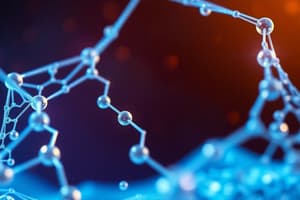Podcast
Questions and Answers
What is the primary structural characteristic of graphene?
What is the primary structural characteristic of graphene?
- One-atom-thick planar sheets of carbon atoms in a honeycomb lattice (correct)
- A multi-layered structure with varying carbon densities
- A spherical arrangement of carbon atoms
- Three-dimensional network of carbon nanotubes
Which field is expected to benefit most from the unique properties of graphene?
Which field is expected to benefit most from the unique properties of graphene?
- Electronic and optical devices (correct)
- Agricultural fertilizers
- Civil engineering materials
- Pharmaceutical drug delivery
What is the main focus of industrial graphene metrology?
What is the main focus of industrial graphene metrology?
- Creating graphene-based composite materials
- Evaluating the reliability and performance of graphene in large-scale applications (correct)
- Developing new methods for graphene synthesis
- Studying the theoretical properties of graphene
Which of the following is a key concern when addressing reliability issues of graphene at an industrial scale?
Which of the following is a key concern when addressing reliability issues of graphene at an industrial scale?
What does graphene metrology aim to quantify?
What does graphene metrology aim to quantify?
Why is it important to quantify the Fermi level in graphene?
Why is it important to quantify the Fermi level in graphene?
Which of these factors is crucial for determining the suitability of a graphene metrology technique for industrial use?
Which of these factors is crucial for determining the suitability of a graphene metrology technique for industrial use?
What role does sensitivity to the substrate play in graphene metrology?
What role does sensitivity to the substrate play in graphene metrology?
How does fluorescence quenching aid in large-area graphene metrology?
How does fluorescence quenching aid in large-area graphene metrology?
What advantage does fluorescence-quenching metrology offer over other techniques in industrial settings?
What advantage does fluorescence-quenching metrology offer over other techniques in industrial settings?
Which property of graphene is most directly related to its potential use in high-speed electronics?
Which property of graphene is most directly related to its potential use in high-speed electronics?
How might defects in graphene affect its performance in electronic devices?
How might defects in graphene affect its performance in electronic devices?
In the context of graphene production, what does 'patternability' refer to?
In the context of graphene production, what does 'patternability' refer to?
What should be considered to improve graphene's performance in thermal management applications?
What should be considered to improve graphene's performance in thermal management applications?
What is a key consideration when selecting a graphene metrology technique for industrial quality control?
What is a key consideration when selecting a graphene metrology technique for industrial quality control?
Which factor is most likely to limit the use of a highly accurate but slow graphene metrology technique in a mass-production setting?
Which factor is most likely to limit the use of a highly accurate but slow graphene metrology technique in a mass-production setting?
How does the edge structure of graphene sheets impact their overall properties?
How does the edge structure of graphene sheets impact their overall properties?
What is the significance of achieving quantified results in graphene metrology?
What is the significance of achieving quantified results in graphene metrology?
In the context of graphene metrology, what is meant by 'sensitivity to the environment'?
In the context of graphene metrology, what is meant by 'sensitivity to the environment'?
For industrial applications, why is it important for graphene metrology techniques to be substrate-independent?
For industrial applications, why is it important for graphene metrology techniques to be substrate-independent?
Flashcards
Graphene
Graphene
An allotrope of carbon consisting of one-atom-thick planar sheets of carbon atoms arranged in a honeycomb lattice.
Graphene Metrology
Graphene Metrology
Evaluating the consistency & dependability of graphene devices, considering defects, pattern quality, and electrical/physical traits.
Fluorescence Quenching Metrology
Fluorescence Quenching Metrology
A method measuring graphene using the reduction in intensity of light emitted by a fluorescent substance when graphene is present.
Layer Thickness
Layer Thickness
Signup and view all the flashcards
Edge Structure
Edge Structure
Signup and view all the flashcards
Defects
Defects
Signup and view all the flashcards
Fermi Level
Fermi Level
Signup and view all the flashcards
Thermal Conductivity
Thermal Conductivity
Signup and view all the flashcards
Throughput
Throughput
Signup and view all the flashcards
Scalability
Scalability
Signup and view all the flashcards
Sensitivity to Substrate/Environment
Sensitivity to Substrate/Environment
Signup and view all the flashcards
Ability to Achieve Quantified Results
Ability to Achieve Quantified Results
Signup and view all the flashcards
Study Notes
- Graphene is an allotrope of carbon with a structure based on one-atom-thick planar sheets.
- The carbon atoms in graphene are densely packed in a honeycomb crystal lattice.
- Graphene's unique electrical and optical properties have generated interest in designing future electronic and optical devices.
- Extensive efforts are studying the reliability and performance of graphene devices.
- Advances in synthesizing large-area graphene sheets have led to investigations into graphene metrology and quality control at industrial scales.
- These investigations aim to understand reliability issues, including defects, patternability, and electrical and physical properties.
- Industrial graphene metrology techniques are being developed and assessed.
- Industrial metrics measured include layer thickness, edge structure, defects, Fermi level, and thermal conductivity.
- Measurements are performed using a variety of techniques, each with its advantages for industrial use.
- Advantages include throughput, scalability, sensitivity to substrate/environment, and the ability to achieve quantified results.
- Fluorescence-quenching metrology is a recently developed large-area graphene metrology technique.
- Fluorescence-quenching technique meets the necessary criteria for industrial applications.
- Fluorescence-quenching is potentially the first industry-ready graphene metrology technique.
Studying That Suits You
Use AI to generate personalized quizzes and flashcards to suit your learning preferences.




